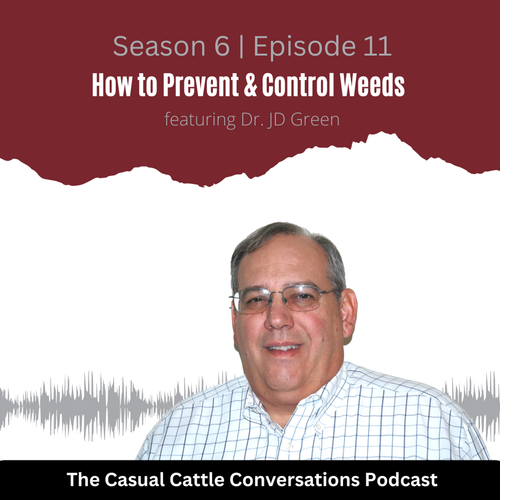The Casual Cattle Conversations Podcast: How to Prevent & Control Weeds
Thursday, March 16, 2023
Reference: Podcast Corner

How to Prevent & Control Weeds
March 13 | Written By Shaye Koester
We all know the feeling of driving through a pasture or hay field and seeing those pesky plants that do not belong. Weeds impact the performance of the rest of your forages and can even be detrimental to the health of your livestock if they are poisonous. Dr. JD Green joins the podcast from the University of Kentucky to share strategies cattle producers can use to prevent and control weeds in their pastures and hay fields. Click Here to listen to Shaye's Podcast
Why Weed Control Matters
Controlling weeds in your pastures and hay fields ultimately impacts your bottom line when you look at how weeds impact not only the quality and quantity of forage produced but also if they are potentially poisonous for livestock to consume. Dr. Green says, “Weeds can reduce forage quantity, or the amount of forage that's produced. And subsequently, if we're reducing the number of desirable forages available for us, then it also can reduce the carrying capacity of the number of animals we'd like to graze, particularly for those individuals who are trying to maximize the utilization of their available land resources.”Outside of forage quantity, weeds impact forage quality as well. This can impact the nutritional quality of either what cattle are grazing or consuming through hay that is fed. Dr. Green realizes that some plants that are referred to as weeds can have specific nutritional value if grazed during the appropriate season, but overall, they can still have a negative impact on the overall quality of forage that is available for consumption or hay production.
The Best Method for Weed Control
There is no one-size-fits-all approach to weed prevention and control. Dr. Green urges cattle producers to use an integrated approach and systems thinking mindset as they tackle this portion of forage management. An integrated approach to weed management includes evaluating cultural practices, mechanical control and herbicides.Two cultural practices to evaluate are grazing and interseeding. “I like rotational grazing systems because we give a chance for the grass to get a little rest and revive between grazing cycles. Therefore, we're not stressing the root systems of the desirable plants as much. Animals are selective grazers and they typically select for and consume desirable plants, and leave behind what they don't like. So, when we leave those unwanted plants, which are the primary weeds we have in Kentucky and I suspect across the US, those are the plants that can go through their reproductive phases, and subsequently, we get a shift towards more weedy type plants, and that kind of environment.”, says Green.
Mechanical control and the use of herbicides are two other methods of weed control that can be used in an integrated approach. Effective mechanical control consist of cutting or mowing weeds before they have a chance to produce an abundance of new seed but also doing so in a way that potentially reduces weed populations that are already present. Herbicide control consists of spraying weeds with the appropriate chemical to control their growth and reproduction.
No matter which weed control method you use, understanding your timing and environment are critical components of being successful in killing current weed populations and reducing the population for the next growing season.
Where Do Cattle Producers Start?
There are many variables when it comes to weed control and prevention. Dr. Green provides a few questions for cattle producers to ask themselves as they navigate this process.“What are my most troublesome weed problems?”
“How do these weeds grow and develop?”
“How do they reproduce?”
“Are they annuals that only reproduce by seed or perennials that can regrow from the same root system?”
“Relative to my desirable forages how many weeds are present?”
“Is there a high enough weed population to justify more drastic approaches for control?”
These questions serve as a starting point. Green encourages cattle producers to look at their entire operation and think about their individual situation. Depending on what is being experienced, cattle producers may not have to tackle everything at once. Be patient and know it may take a few years to get things under control and back to where you want. Remember to reach out to experts, ask what works for others in your area and be proactive when it comes to controlling weed populations.
Sign up to stay connected
- News
- Property Alerts
- Save your favourite properties
- And more!
Joining Farm Marketer is free, easy and you can opt out at any time.

